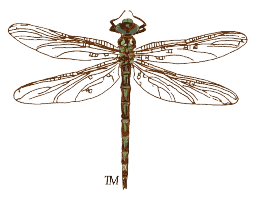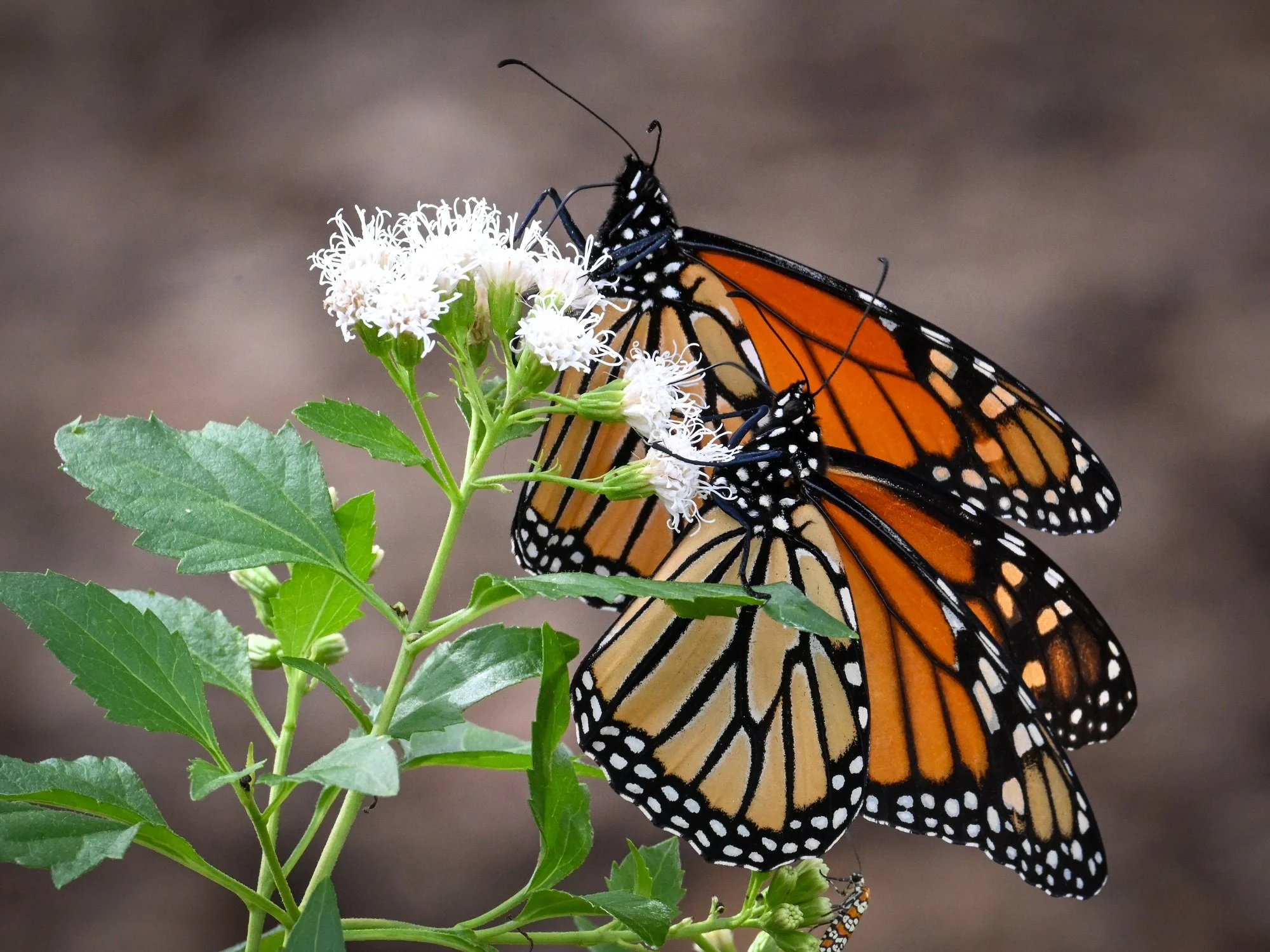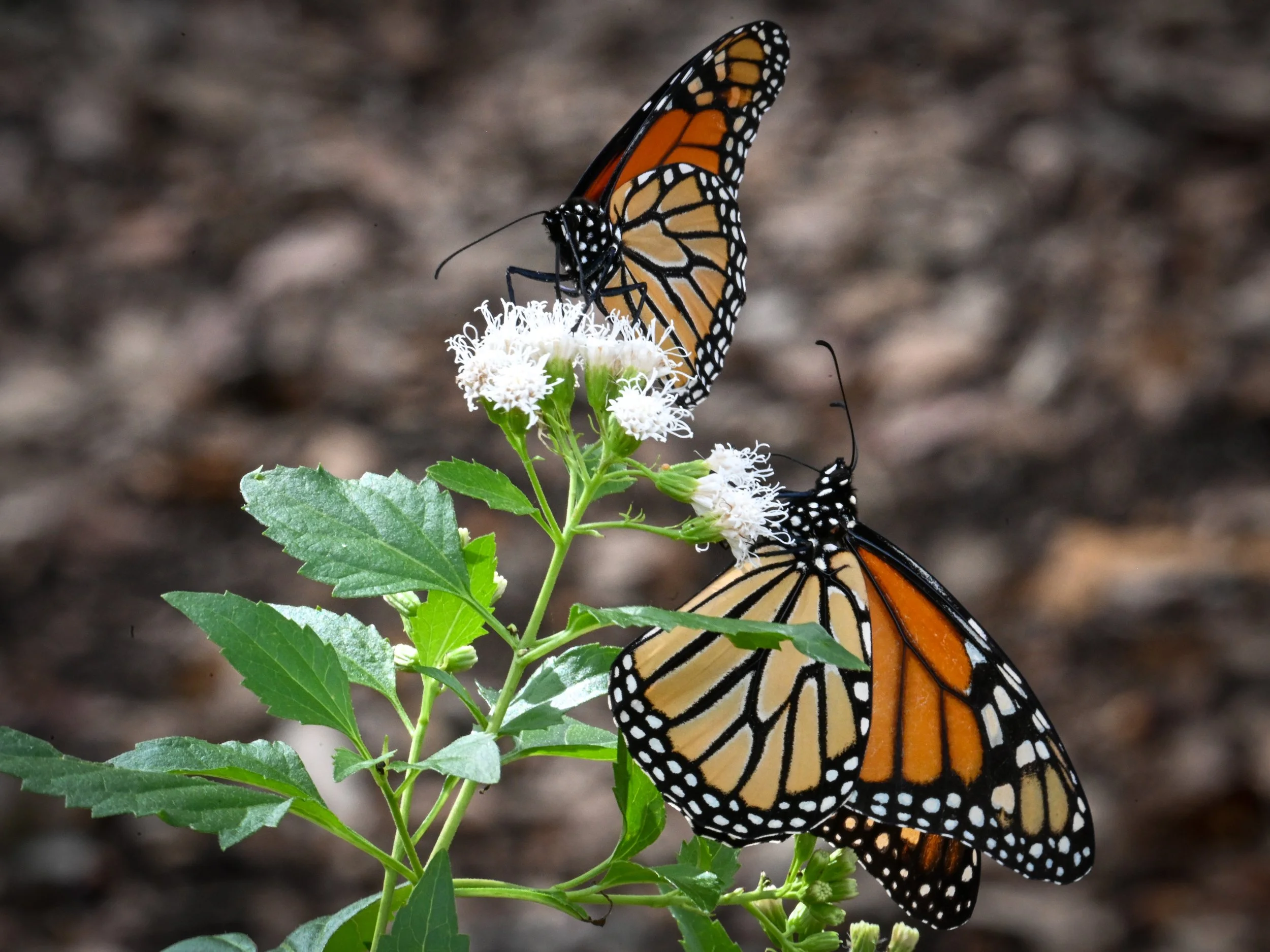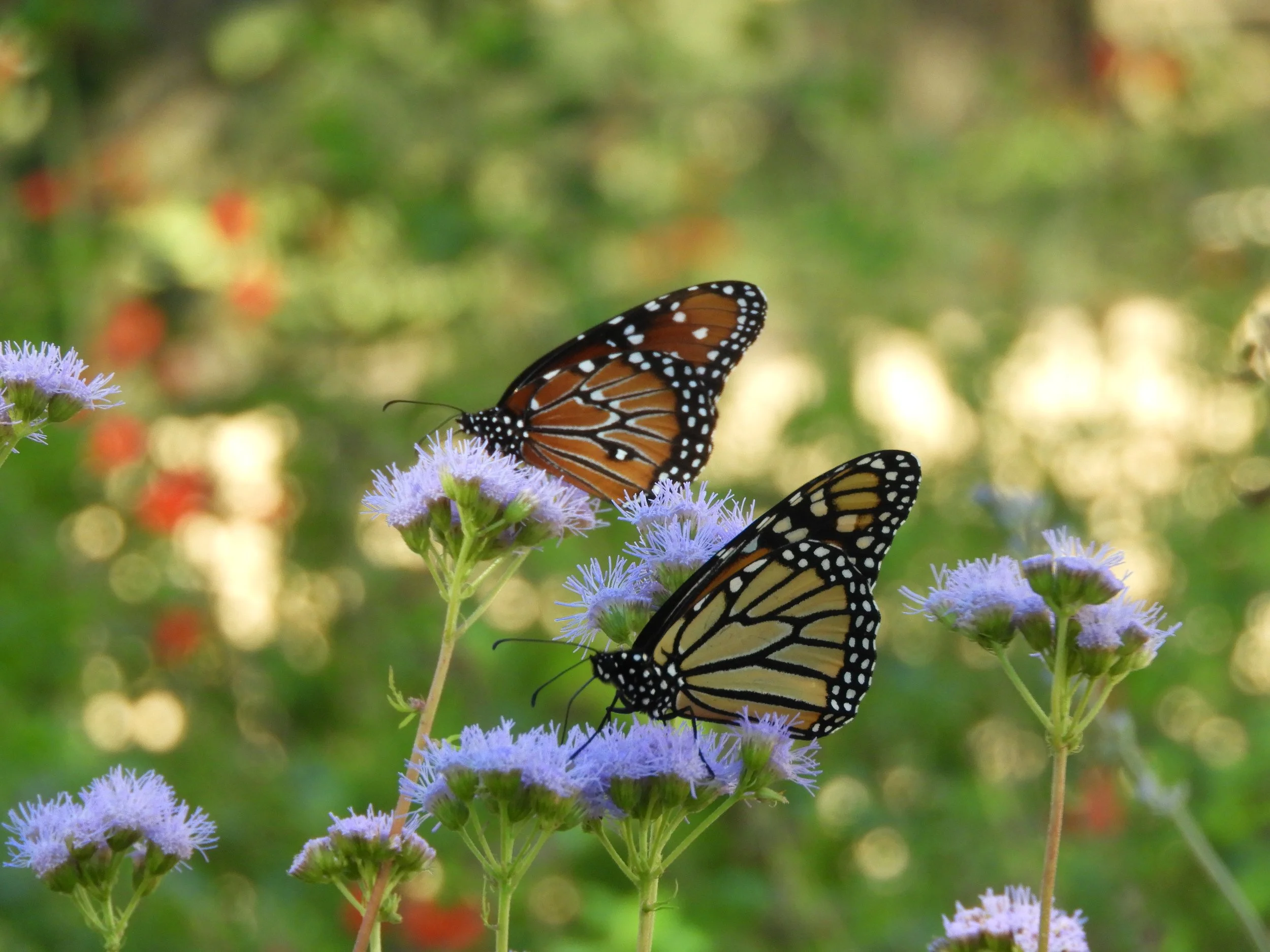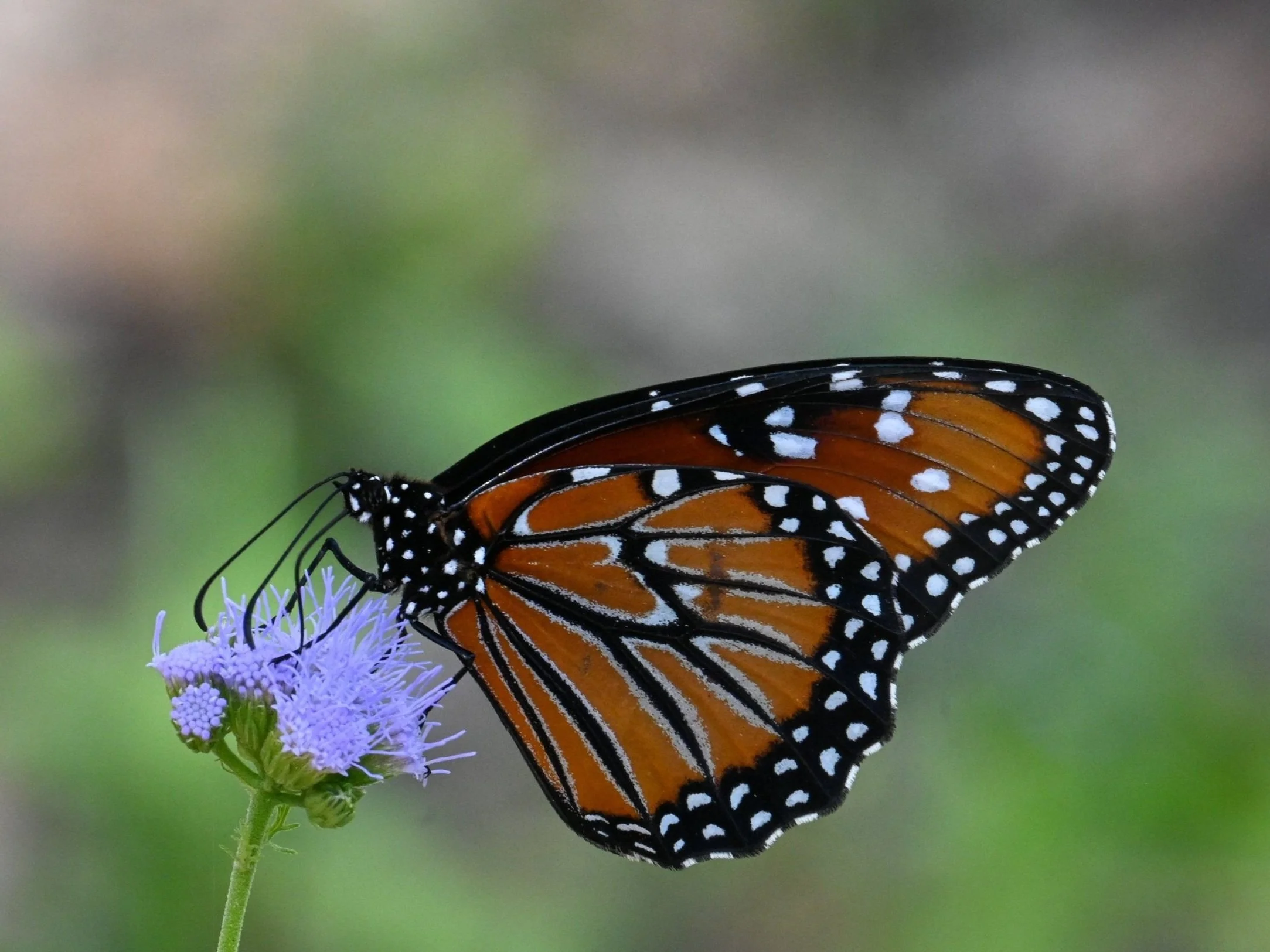About the Cover…
Fall Monarchs on the Move
Two monarch butterflies sample the white mistflower in my yard on October 31, 2023. Photo courtesy Betsy Cross
Did you know that the monarch butterfly was named the state insect of Texas in 1995? Six other states—Alabama, Idaho, Illinois, Minnesota, Vermont, and West Virginia—have also identified the monarch as their official state insect or state butterfly.
Betsy Cross
Mission Impossible?
Each fall, from September through November, monarch butterflies east of the Rocky Mountains embark on an extraordinary journey spanning one thousand to 3,000 miles. The butterflies travel southward across the contiguous United States from southern Canada, the Great Lakes region, and the northeastern U.S., passing through the Texas funnel, and eventually arriving at their overwintering site in Mexico—a place these individuals have never been before.
For monarchs who manage to evade the dangers of this critical leg of their multi-generational life cycle and survive the winter in the oyamel fir forests of Mexico, their journey has not ended. In early spring, these same monarchs will begin a return trip to Texas, laying their eggs on milkweed and reproducing a new generation of monarchs. Their offspring will continue the migration northward, producing two to three more generations of monarchs throughout the spring until they reach their northern destination. In late summer and early fall, a fifth generation will awaken with a new drive to start the southward migration to Mexico, where they will begin the cycle again.
This mysterious, seemingly impossible, mission of the monarch’s migration has intrigued scientists and captivated the hearts of naturalists for generations. Visit the Monarch Watch website for more detailed information, including a map of the spring and fall migration paths of both eastern and western monarch butterfly populations.
The 2024 Fall Migration
On the migration tracking website Journey North—hosted and supported by the University of Wisconsin-Madison Arboretum—citizen scientists and volunteers from Canada, the U.S., and Mexico can log their monarch butterfly counts and observations and upload photos of monarch sightings. As of this writing, there was one October 10 entry posted by a Hays County volunteer in Driftwood of a single monarch nectaring on frostweed along with dozens of queen butterflies. Citizen scientists at four other Texas sites outside of our area, reported as many as a thousand roosting monarchs to Journey North during the week of October 10.
This year’s fall monarch migration appears to be off to a slow start in my San Marcos, Texas, neighborhood. Midway through the month of October, I have seen only one monarch butterfly.
My first fall monarch nectared on frostweed - September 25, 2024, San Marcos, Texas. Photo courtesy Betsy Cross
A recent article by Monika Maeckle, San Antonio author and founder of the Texas Butterfly Ranch, provides a discussion about the state of the 2024 fall monarch population. In her article, “Weird” weather has scientists concerned about this year’s monarch butterfly migration, Maeckle presents perspectives from monarch butterfly scientists Chip Taylor, Karen Oberhauser, Wendy Caldwell, Kristen Baum, and David James, each of whom expresses concern about the status of the population and elaborates on factors that may be influencing the 2024 fall migration. Various longtime citizen scientists and monarch taggers also weigh in, noting their observations of a decline in this year’s fall monarch sightings.
Many of the issues that impact monarch populations and their migration seem apparent: habitat loss, pesticides, herbicides, and weather patterns, including hurricanes, drought, and climate change in general. The researchers who are capturing the data and trending monarch populations over time will continue to correlate the factors and provide future insights and strategies. In the meantime, what can regular citizens, nature enthusiasts, and monarch advocates do to improve the conditions that support and enhance the long term outlook for this cherished orange and black insect?
The Role of Fall Nectar Plants
It takes a huge amount of energy to fly thousands of miles across the U.S. and into Mexico during the fall migration. Regardless of the numbers of monarchs passing through our area, for the ones who do visit our yards and natural areas, they will be seeking nectar sources to fuel their journey and to build the fat reserves required to overwinter in the oyamel forests of Mexico and launch a spring return to Texas. Fall blooming nectar plants are critical to the monarchs’ health, endurance, and a successful spring reproduction cycle.
One such fall blooming native wildflower here in Central Texas is frostweed. It is an excellent nectar source for pollinators and butterflies of all kinds and is widely available, easily cultivated, and for the most part, it’s a free resource to land owners. I’ve seen first hand its importance to migrating monarch butterflies. When it is available, it attracts the monarch migrants in large numbers and appears to be one of their preferred nectar sources.
Frostweed (Verbesina virginica)
Blooms July - December
One of the challenges facing migrating monarch butterflies, however, is the synchronous timing of the butterflies’ arrival with the availability of wild nectar plants. This year’s summer rains raised my hopes that by fall we would have lots of flowering frostweed for migrating monarchs. But in the weeks since those July and early August surprise rain events, a lack of measurable rainfall, along with high, sometimes record-setting temperatures, has been tough on frostweed. Its nectar-rich flowers are dry and wilted in most unirrigated landscapes. And with no rain in the forecast, it’s unlikely that frostweed will supply late October- and early November-arriving monarchs with significant nectar this year. However, there are other native fall blooming plants that can furnish the monarchs’ needed nectar, and with focused attention and planning, we can improve our landscapes by planting these natives for all the pollinators that stand to benefit from them.
A hallmark of planting natives in your yard is that they can withstand seasons of drought and heat with minimal requirements. During last year’s hottest, driest summer on record, I was able to keep a few natives blooming, and they served as an important nectar source for the fall monarchs that crossed through my yard. Here are a few photos and names of the fall blooming plants that provided fuel for those migrating monarchs in October 2023.
Flame Acanthus (Anisacanthus quadrifidus var. wrightii)
Blooms June - November
Gregg’s Mistflower (Conoclinium greggii)
Blooms March - November
White Mistflower or Shrubby Boneset (Ageratina havanensis)
Blooms April - December
Mealy Blue Sage (Salvia farinacea) - White and Blue
Blooms April - October
In closing, here are some actions that each of us can take to improve the conditions that support and enhance the long term outlook for monarchs:
Focus on planting natives that provide nectar to monarchs and other pollinators. A few additional fall native nectar plants to consider in your landscape include Fall Aster, Maximillian Sunflower, Goldenrod, and Texas Lantana.
Learn to identify fall blooming native plants that grow wild in our area and encourage their growth and propagation.
Learn to identify and protect our native milkweed species and add native milkweed to your gardens. Remember that monarchs who migrate thousands of miles in the fall will pass through again in March on their journey north in search of milkweed for the next generation.
Become a citizen scientist and report your monarch observations and sightings.
Join a nature group or a native plant society to further your knowledge, and participate in projects that multiply your impact, such as developing a community pollinator garden or a monarch waystation.
For additional information and ideas, review this article by Matt Morris of the Zilker Botanical Garden in Austin: The Importance of Fall Nectar Plants for the Monarch Butterfly
Monarchs and Queens Are Closely Related
Monarchs and queens belong to the same subfamily, Danainae, and have a lot in common. They are similar in color and size, and both lay their eggs on milkweed. During the fall migration, queens and monarchs may be seen together, often nectaring on the same flowers. For these reasons, they can be easily misidentified.
Can you tell the difference?
Looking at these two butterflies side by side on Gregg's mistflower, you may begin to note their differences.
Let’s take a little closer look.
Monarch (Danaus plexippus)
With wings folded, the monarch's hindwings are a lighter orange, while the forewings are mostly a deeper amber. Both fore- and hindwings have bold black lines that create a "stained glass" appearance, and the fore- and hindwings only have white dots within the black borders.
Queen (Danaus gilippus)
With wings folded, the queen's fore- and hindwings are uniformly orange and have a brownish tint in color. Forewings lack the bold black lines characteristic of the monarch, and the white dots lie within both the orange forewings and the black borders.
